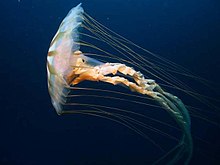Chrysaora melanaster
| Chrysaora melanaster | |
|---|---|

| |
| Scientific classification | |
| Domain: | Eukaryota |
| Kingdom: | Animalia |
| Phylum: | Cnidaria |
| Class: | Scyphozoa |
| Order: | Semaeostomeae |
| Family: | Pelagiidae |
| Genus: | Chrysaora |
| Species: | C. melanaster
|
| Binomial name | |
| Chrysaora melanaster (Brandt, 1835)
| |
The northern sea nettle (Chrysaora melanaster), also called a brown jellyfish, is a species of jellyfish native to the northern Pacific Ocean and adjacent parts of the Arctic Ocean. (It is sometimes referred to as a Pacific sea nettle, but this name is also used for Chrysaora fuscescens; the name Japanese sea nettle was used for this species, but that name now exclusively means Chrysaora pacifica.[1][2] This jelly's medusa can reach 60 centimeters in length with tentacles growing up to three meters.[3][4] The number of tentacles is up to 24 (8 per octant).[1] It dwells at depths of up to 100 meters, where it feeds on copepods, larvaceans, small fish, large zooplankton, and other jellies.[4] The sting is mild, although can cause serious skin irritation and burning.[5]
-
Japanese Sea Nettle Chrysaora pacifica
-
Japanese Sea Nettle, New England Aquarium
-
Swimming movement of the Japanese Sea Nettle, Albuquerque Aquarium
References
- ^ a b Morandini AC, Marquess AC (2011) Revision of the genus Chrysaora Péron & Lesueur, 1810 (Cnidaria: Scyphozoa). Zootaxa 2464: 1–97
- ^ "Fact Sheet: Japanese Sea Nettle" (PDF). Shedd Aquarium. Retrieved January 2012.
{{cite web}}: Check date values in:|accessdate=(help) - ^ CNET news, Chrysaora melanaster, from "Census of Marine Life reveals hidden life in oceans" article (October 5, 2010).
- ^ a b "Sea Nettle: Chrysaora melanaster". Census of Marine Life Arctic Ocean Diversity project. August 20, 2010.
- ^ "Jellies Invasion: Explore Online". National Aquarium in Baltimore. Retrieved January 2012.
{{cite web}}: Check date values in:|accessdate=(help)


